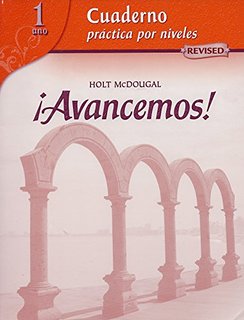
All Solutions
Page 200: Gramatica A
The purpose of this exercise is to practise the use of the verbs “ser” and “estar” in Spanish.
By now, you have learned that Spanish includes two verbs with the meaning “to be”. Even though they are synonyms, they are not interchangeable. Each verbs carries its own value, thus:
A. The verb “ser” will be used for permanent features, time and similar values.
Example 1: Ana es alta, rubia y perezosa.
Example 2: La clase es a las once.
Regarding Example 1, you know that hair can be dyed in minutes. However, in terms of language, this is irrelevant, just like the fact that one can easily get up and get things done. This will, nonetheless, not change the fact that this person is generally lazy.
Example 3: Ana está enferma.
Example 4: Ana está en la clase.
When you learn and understand the values these two verbs have, you will easily manage their use. You will then notice how you can differentiate between a permanent and a temporary feature. For instance:
Example 5: Ana es feliz.
Example 6: Ana está feliz.
In Example 5, you are saying that Ana is generally a happy person, no matter the circumstances. However, in Example 6 you are specifying that Ana is happy for the time being. She could have won the lottery, for instance.
Finally, there are adjectives the meaning of which will drastically change depending on whether you use either “ser” or “estar”. You will learn more about such cases with further practice as time goes by.
Example 7: Ana es lista.
Example 8: Ana está lista.
In example 7, it says that Ana is bright, intelligent, whereas the last example states that Ana is ready (for something). Note that because the meaning changes, the verbs “ser” and “estar” are not interchangeable.
In this exercise, there is a set of five incomplete sentences. You will read them carefully to understand their meaning. Pay attention to the value the verb “to be” expresses: is it temporary of permanent? Then, according to the meaning, use either “ser” or “estar” to complete the sentences. Remember to always match the verb with the grammatical subject. You may follow the below solutions for further guidance.
2. están
3. estamos
4. eres
5. es
The objective of this exercise is to practise the use of the verbs “ser” and “estar” in Spanish.
In this exercise, you are given a set of eight incomplete sentences. You will read them carefully to understand their meaning. Then, you will use the appropriate conjugated form of either “ser” or “estar”. When choosing between the two, pay attention to the permanent or temporary value of the meaning. Remember to always match the verb with the grammatical subject. You may follow the below solutions for further guidance.
2. está
3. somos
4. están / estáis
5. son
6. están
7. estás
8. estoy
The objective of this exercise is to practise writing in Spanish whilst using the verbs “ser” and “estar”.
For this exercise, you will answer two questions. One uses the verb “estar”, and the other one, “ser”. Pay attention to how these two verbs modify the meaning of the interrogative adverb “cómo”. Below, you will find analyses for the two questions to further clarify the topic. Given the personal nature of this exercise, only use the below examples as a reference.
¿Cómo estás?
In this question, “how” is used with the verb “estar”. Previously, you have answered questions along the lines of: “¿Cómo eres?”. Your answer included a description of yourself because of the permanent value of “ser”. When used with the verb “estar”, thus when referring to a temporary value, it asks you how you are feeling for the time being. Hence, you would not say that you are tall, blond or athletic; you would say something like “fine, well, bad, etc.”.
Example 1: Estoy bien, gracias.
Example 2: Estoy mal.
¿Cómo son tus amigos o tus amigas?
Just like it was mentioned in the previous paragraph, the verb “ser” refers to permanent features. Unlike the previous question, this time you are asked to describe your friends.
Example 1: Mis amigos son altos, atléticos y estudiosos.

